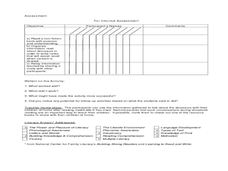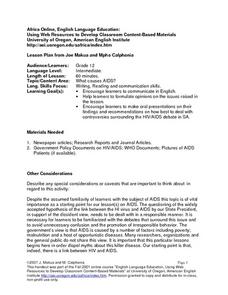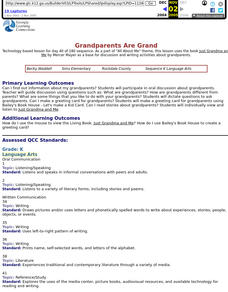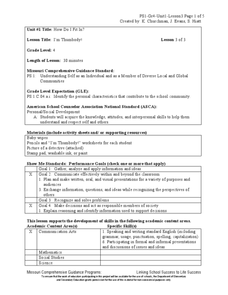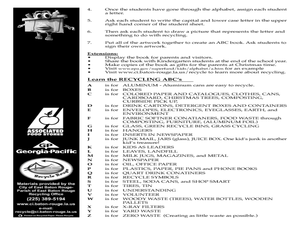Curated OER
Food Pyramid
Second graders are introduced to the food groups on the food pyramid. Individually, they draw pictures of their favorite foods and identify which food group it belongs. To end the lesson, they discuss the importance of eating a variety...
Curated OER
Who Am I and Who Are You?
Students document their unique characteristics through photography. In this self-discovery instructional activity, students take photographs of themselves and others. As a class, they discuss similarities and differences, and sort,...
Curated OER
Digging for Dinosaur Information
Students explore how to locate dinosaur information. They read the book, Catch Me If You Can! and discuss the popularity of dinosaurs among children, identify various kinds of dinosaurs and select a dinosaur to research. TAs they...
Curated OER
What Causes AIDS?
Twelfth graders in an ESL classroom use the internet to research the causes of AIDS. As a class, they discuss the topics mentioned in the various websites and determine if they are viable causes for the disease. They create a...
Curated OER
Theatre Prop Design and Construction
Fourth graders construct individual props. In this theatrical arts lesson, 4th graders use the elements of art to create various props using paper mache. Students construct objects such as logs, fruit, and a picture frame.
Curated OER
Grandparents Are Grand
Students to interview their grandparents. It uses the book, "Just Grandma and Me." students brainstorm and select the questions they each ask their grandparents.
Curated OER
Arkansas Photographs as Research Tools
Middle and high schoolers look at historical photos and written materials, and they develop questions which they use to interview an elder in their community. Learners are divided into groups and given sets of historical family photos...
Cornell University
The Physics of Bridges
Stability is key when building a bridge. Scholars explore the forces acting upon bridges through an analysis of Newton's Laws and Hooke's Law. The activity asks individuals to apply their learning by building a bridge of their own.
Virginia Department of Education
Weather Patterns and Seasonal Changes
Get your class outside to observe their surroundings with a lesson plan highlighting weather patterns and seasonal changes. First, learners take a weather walk to survey how the weather affects animals, people, plants, and trees during...
Curated OER
Camouflage
First graders learn how plants and animals adapt to their environments. In this camouflage lesson, 1st graders watch a movie that explains animal camouflage, design a butterfly that blends into a classroom habitat, create a mini book...
Curated OER
From Human Skeletons to Owl Pellets to Paleontology
Learners explore about the function of the skeleton and comprehend the names of the bones of the human skeleton. They compare bones of the human skeleton to a dinosaur skeleton and graph to compare these bones. Students sort bones to...
Cornell University
Making a Battery
Don't be shocked when your class has a blast making their own batteries! Science scholars examine a dry cell battery, then design and construct a wet cell battery. The activity guides them through the parts of a battery, the variables...
Curated OER
Using Your Marbles - Volume Measurement and Reporting
Demonstrate how to measure the volume of liquids and solids immersed in liquid to your class. They observe a teacher-led demonstration, and in small groups construct a data table that demonstrates how many marbles were used and the...
Scholastic
Transitional Guided Reading
Use a fill-in-the-blank lesson plan template to enhance your guided reading lesson plans with details surrounding decoding strategies, fluency and phrasing, vocabulary strategies, comprehension, and more!
Curated OER
Let's Focus on Idioms
Get online and explore idioms. Your class will use the Internet to locate, choose, and illustrate their favorite idioms. They make a class PowerPoint with illustrations for their idioms and explain the meaning of each. A great way to...
Curated OER
Going Graph-y
Second graders listen to and dicuss the story Where the Wild Things Are. They play a pantomime game and act out various feelings so their classmates can guess. They listen for the frequency of certain words, and record their findings on...
Curated OER
Underground Railroad/Quilts
Students explore the Underground Railroad communication system. In this cross curriculum fine arts and United States history Civil War lesson, students view several websites that feature quilts constructed by slaves during the...
Curated OER
The Iliad
Explore ancient warfare through a dramatic reading of select portions of The Iliad with your class. They will identify the major characters in The Iliad and explain the strategies, external forces, and alliances of the Trojan War
Curated OER
Japan Online Project Lesson Plan
Give your class this introductory activity to spark interest in the Japanese language. Learners look at the Japanese vowels and practice their pronunciation. Then the class works to match vocabulary words to their visual representation.
Curated OER
I'm Thumbody!
Fourth graders write positive statements about themselves. They brainstorm ideas of what a positive thinker looks like and sounds like. Students compare and contrast positive and negative thinking. They complete a worksheet. Students...
Curated OER
The Recycle Alphabet
First graders recognize words associated with recycling. In this environmental lesson, 1st graders go through the alphabet and think of words associated with recycling that start with a letter. Students create a recycling ABC book.
Curated OER
The Envelope Guessing Game
Students work with a partner by using the symbol bracelets from lesson #1. They that has the number #1 look at the object keeping it hidden from student #2. Student number 2 then ask questions in order to determine the qualities and...
Curated OER
Childhood in Early 19th-Century America
Learners interpret and analyze primary source documents and compare and contrast childhood today with that of the past.
Curated OER
Stop Signs, Musical Notes, Letters & Logos: Designing Symbols
Students develop an awareness of environmental print, such as signs, logos, brand names, and other print and non-print items that the children see and read in their neighborhood each day. They then engage in active problem solving as...




